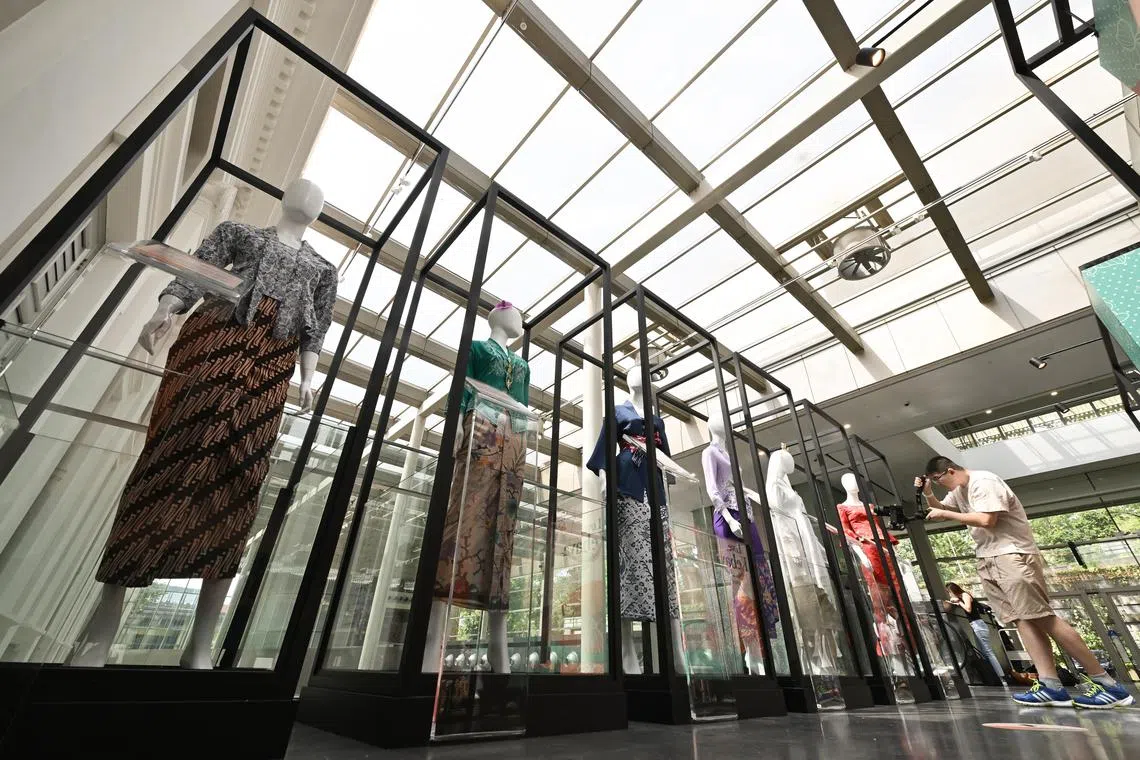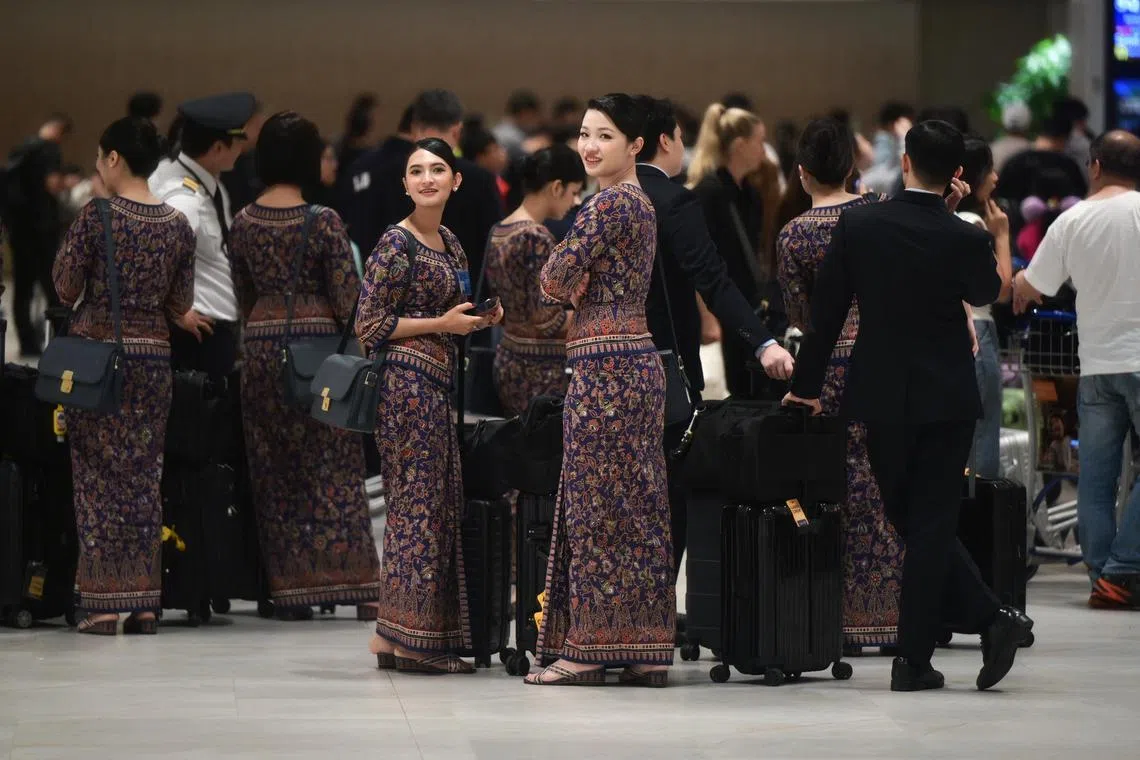Singapore and 4 other nations succeed in getting the kebaya on Unesco intangible cultural heritage list
Sign up now: Get ST's newsletters delivered to your inbox

The Love, Kebaya exhibition at the National Museum of Singapore on April 4, 2023.
ST PHOTO: LIM YAOHUI
Follow topic:
SINGAPORE – The kebaya, a traditional women’s garment popular in South-east Asia, has been officially added to a list of the world’s intangible cultural heritage following a joint nomination by Singapore, Brunei, Indonesia, Malaysia and Thailand.
The outcome was announced at about 9.50pm Singapore time on Dec 4, at the meeting of a 24-member Unesco intergovernmental committee held in Asuncion, Paraguay, where new additions to the Unesco Representative List of the Intangible Cultural Heritage of Humanity were approved.
Intangible cultural heritage refers to traditions or living expressions that are inherited and passed on between generations, such as performing arts, social practices, rituals and festive events.
The inscription of kebaya marks the second time an intangible cultural heritage practice submitted by Singapore has made it to Unesco’s list. In 2020, hawker culture was added to the list following its nomination by Singapore.
The kebaya, a long-sleeved upper garment
When the National Heritage Board (NHB) announced its intention to be a part of the joint submission in November 2022,
The kebaya, for instance, is worn by flight attendants of national carriers Singapore Airlines, Malaysia Airlines and Garuda Indonesia.

Singapore Airlines air stewardesses dressed in the carrier’s signature kebaya at Changi Airport Terminal 2 on Dec 4.
ST PHOTO: AZMI ATHNI
NHB added in 2022 that in Singapore, the garment is associated with the Malay and Peranakan communities, among others, and represents a significant part of the country’s port heritage.
The joint submission – mooted by Malaysia and titled Kebaya: Knowledge, Skills, Traditions And Practices – was submitted to Unesco in March 2023, and supported by groups and individuals in Singapore such as Peranakan culture non-profit organisation Gunong Sayang Association and kebaya maker Raymond Wong.
Shortly before the successful inscription was announced on Dec 4, a 12-member evaluation body, which considers nominations and makes recommendations to the 24-member intergovernmental committee, said various communities and stakeholders had actively participated in the joint nomination, and commended the states for a well-prepared file.
In a Facebook post published after the Unesco decision, Minister for Culture, Community and Youth Edwin Tong said the inscription is a proud moment for Singapore and South-east Asia.
Noting that the inscription is the largest to date by South-east Asian states based on the number of countries involved, Mr Tong said the kebaya reflects the unique blend of cultures in the region, and “is a wonderful representation of our multiculturalism”.
The NHB said in a press statement on Dec 4 that the nominating countries were commended for the level of community participation at both the national and regional levels during the nomination process.
For instance, the board’s Love, Kebaya travelling exhibition
Designer Sufiyanto Amat Sopingi, the founder of Kebaya Societe, a social media account showcasing vintage fashion in the Malay-Indonesian world, said the inscription recognises the kebaya “on a global scale as a garment that’s synonymous with our region”.
Looking ahead, the garment will be highlighted during the annual Singapore HeritageFest in May 2025, said the board.
It will also be developing a kebaya digital game for upper primary pupils, set to be launched in the first quarter of 2025, as well as a resource kit for lower primary pupils slated to be ready in the third quarter of the same year.
Unesco’s Representative List of the Intangible Cultural Heritage of Humanity is made up of practices that help demonstrate the diversity of this form of heritage, and raises awareness of its importance.
As at Dec 3, 628 elements have been added to the list. The latest inscriptions include Thailand’s tom yum kung prawn soup,
NHB said in 2022 that inscription helps to increase visibility, awareness and appreciation of heritage practices, adding that successful listing of an element does not imply that it belongs to, originates from, or belongs only in the submitting country.

Representatives from the five states in the joint nomination for the kebaya, including NHB’s group director for policy and community Yeo Kirk Siang and NHB chief executive Chang Hwee Nee (back row, second and third from left), in Asuncion, Paraguay, following the successful inscription.
PHOTO: NHB
Only states that have ratified the 2003 Unesco Convention for the Safeguarding of the Intangible Cultural Heritage, which commits signatories to protecting and promoting intangible cultural heritage practices, are allowed to make nominations for Unesco’s list.
Signatories are required to submit a report on their efforts to safeguard intangible cultural heritage once every six years, and Singapore’s first report – after ratifying the convention in February 2018 – is due on Dec 15.
Together with Malaysia, the country is planning to submit a joint nomination for the Chingay parade


